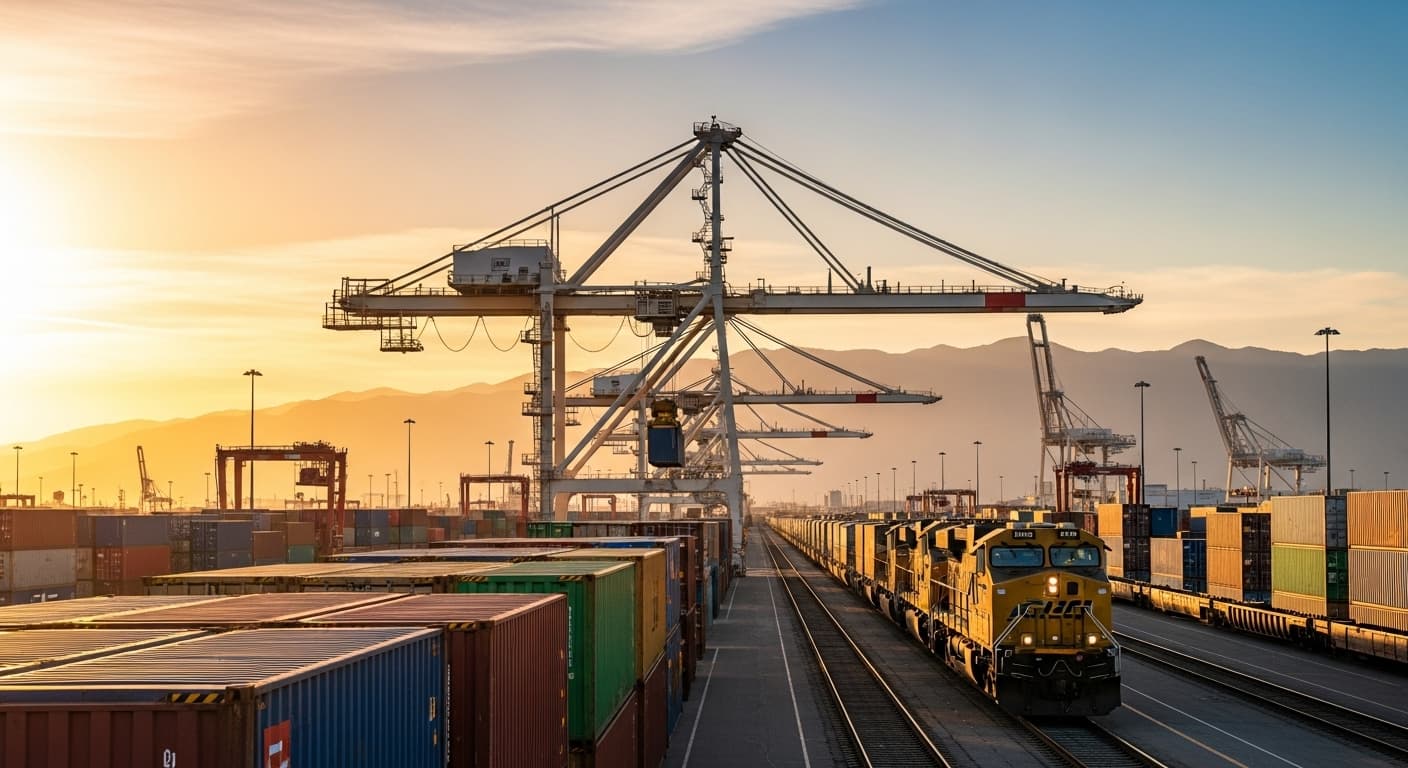
Executive Summary
The 2025 intermodal peak season has arrived earlier than traditional patterns suggest, with Southern California experiencing significant volume surges and corresponding rate increases. Double-digit pricing growth on outbound West Coast lanes reflects tight capacity, proactive carrier strategies, and shifting inventory management practices. Understanding the drivers behind this early peak season and their implications for transportation strategy enables shippers and logistics providers to navigate the current market environment effectively.
Understanding the Early 2025 Intermodal Peak Season: Market Dynamics and Strategic Implications
(了解2025年提前到来的多式联运旺季:市场动态与战略影响)
1 · The Early Peak Season Phenomenon
Traditionally, intermodal peak season intensifies in September and October as retailers stock inventory for holiday shopping periods. The 2025 season has deviated from this pattern, with peak conditions emerging in August and early fall, creating operational challenges and pricing pressures that caught some market participants unprepared.
Defining the Current Market Environment
Volume Surge Characteristics: Southern California, particularly the Los Angeles basin, has experienced substantial increases in outbound intermodal volumes earlier than historical patterns would predict. This demand concentration reflects the region’s role as the primary gateway for Asian imports and distribution center for serving national markets.
Rate Impact Magnitude: Outbound West Coast intermodal lanes have seen rate increases exceeding 10% compared to pre-peak benchmarks, with some lanes experiencing even steeper growth. These increases represent significant shifts in transportation economics for shippers dependent on these critical trade corridors.
Geographic Concentration: While Southern California experiences the most pronounced impacts, the effects ripple throughout Western intermodal networks. Eastbound lanes originating from Los Angeles, Long Beach, and Inland Empire facilities face particular pressure as equipment and capacity constraints affect service availability.
Historical Context and Pattern Deviation
Traditional Peak Season Timeline: Historically, intermodal peak season builds gradually through September, reaches maximum intensity in October, and begins moderating in November as holiday shipping deadlines pass. This pattern aligned with ocean shipping schedules and retail inventory planning cycles.
2025 Pattern Deviation: The current year’s early onset reflects several converging factors that have compressed typical seasonal patterns and created peak conditions weeks ahead of historical norms. Understanding these factors helps explain current market dynamics and inform strategic planning.
2 · Drivers of Early Peak Season Conditions
Multiple factors have combined to create early peak season conditions, each contributing to the capacity constraints and pricing pressures characterizing the current market environment.
Port Volume Dynamics
Import Surge Timing: West Coast ports, particularly the Port of Los Angeles and Port of Long Beach, have handled substantial import volumes throughout summer and early fall. This sustained activity reflects various factors affecting international trade flows and domestic inventory strategies.
Trade Policy Considerations: Ongoing discussions about tariff policies and trade frameworks have influenced import timing decisions. Some importers accelerated shipments to ensure inventory availability ahead of potential policy changes, creating concentrated demand periods that strain intermodal capacity.
Ocean Carrier Scheduling: Ocean carrier schedules and vessel arrival patterns affect when containers become available for intermodal movement. Concentrated vessel arrivals can create pulses of demand exceeding available intermodal capacity, particularly when multiple large vessels arrive within short timeframes.
Port Efficiency Factors: Port operations, including container dwell times, chassis availability, and terminal productivity, influence how quickly import containers move to intermodal facilities. Operational constraints at ports can create backups that compress subsequent intermodal movements into shorter periods.
Inventory Management Strategies
Forward Demand Pull: Many retailers and distributors have adjusted inventory strategies to ensure product availability for holiday selling seasons. This forward demand pull moves traditional peak season timing earlier, as companies seek to position inventory ahead of potential supply chain disruptions.
Safety Stock Considerations: Uncertainty about supply chain reliability has led some companies to maintain higher safety stock levels than historical norms. Building these safety stocks requires sustained transportation capacity throughout periods traditionally considered shoulder seasons.
Distribution Center Constraints: Warehouse and distribution center capacity limitations affect inventory flow timing. When distribution centers reach capacity constraints, they may slow inbound shipments, creating irregular demand patterns that complicate capacity planning for intermodal providers.
Inventory Velocity Changes: E-commerce growth and changing retail models have altered inventory velocity requirements. Faster inventory turns and more frequent replenishment cycles create sustained transportation demand rather than concentrated seasonal peaks.
Carrier Capacity Management
Proactive Peak Season Declarations: Some intermodal providers declared peak season conditions weeks ahead of traditional timing, implementing surcharges and capacity management programs earlier than historical patterns. These proactive strategies reflect lessons learned from previous peak seasons and efforts to balance demand with available capacity.
Equipment Positioning: Intermodal equipment—containers, chassis, and railcars—must be positioned appropriately to meet demand. Early peak season conditions can strain equipment pools, particularly when demand concentrations occur in specific geographic areas like Southern California.
Railroad Service Considerations: Railroad service capacity and operational efficiency significantly affect intermodal capabilities. Train schedules, terminal capacity, and crew availability all constrain how much volume intermodal networks can handle, regardless of demand levels.
Driver Availability: Drayage driver availability affects intermodal efficiency at both origin and destination points. Southern California’s dray market faces ongoing driver capacity challenges that can limit intermodal throughput even when rail capacity remains available.
3 · Rate Structure and Pricing Dynamics
The early peak season has created complex pricing dynamics affecting different market segments and lanes in varying ways.
Understanding Rate Increases
Double-Digit Growth Factors: Rate increases exceeding 10% on key West Coast lanes reflect multiple factors beyond simple supply-demand imbalances. Understanding these components helps shippers evaluate pricing and consider strategic alternatives.
Cost Components:
- Base Rate Adjustments: Underlying rate increases reflecting operational costs and market conditions
- Peak Season Surcharges: Additional charges specifically implemented to manage peak demand
- Fuel Surcharges: Fuel price adjustments affecting overall transportation costs
- Accessorial Charges: Various fees for specific services or handling requirements
Lane-Specific Variations: Not all lanes experience identical pricing pressure. Outbound Southern California lanes face steeper increases than other regions due to capacity constraints and demand concentration. Understanding lane-specific dynamics helps optimize network strategies.
Peak Season Surcharge Evolution
Initial Surcharge Levels: Early peak season surcharge announcements included substantial fees, with some carriers implementing surcharges approaching $1,500 per load. These initial levels reflected carriers’ assessment of capacity constraints and demand intensity.
Market Response and Adjustments: Market forces and competitive dynamics led to surcharge adjustments over time, with some carriers reducing initial surcharge levels to more moderate amounts around $800 per load. This adjustment process reflects negotiations between carriers and shippers and competitive pressure within the intermodal market.
Timing and Duration: Peak season surcharges typically remain in effect for defined periods, though exact timing varies by carrier and lane. Understanding surcharge duration helps with budget planning and transportation strategy development.
Contractual Considerations: Shippers with existing contractual agreements may have different surcharge exposure than spot market participants. Contract terms regarding peak season provisions significantly affect total transportation costs during high-demand periods.
Spot Market versus Contract Rates
Spot Market Volatility: Spot market rates demonstrate greater volatility than contract rates, rising more steeply during capacity constraints and potentially declining more sharply when demand moderates. Spot market dynamics provide real-time indicators of capacity availability and pricing pressure.
Contract Rate Stability: Contract rates typically provide greater stability but may not capture short-term market fluctuations. The balance between contract and spot market exposure represents an important strategic decision affecting cost predictability and flexibility.
Intermodal-Truckload Relationship: Intermodal spot rates correlate closely with over-the-road truckload pricing. When truckload rates rise due to capacity constraints, intermodal becomes more attractive on suitable lanes, increasing intermodal demand and supporting rate growth.
4 · Regional Market Dynamics
While Southern California experiences the most pronounced early peak season effects, understanding regional variations provides important context for strategic planning.
West Coast Concentration
Southern California as Epicenter: The Los Angeles basin functions as the primary pressure point for early peak season conditions. The region’s role as the dominant West Coast import gateway and major distribution center hub creates natural concentration of demand and capacity constraints.
Northern California Dynamics: Oakland and Northern California markets experience related but distinct dynamics. While volumes increase during peak season, the smaller scale relative to Southern California creates different capacity relationships and pricing patterns.
Pacific Northwest Considerations: Seattle-Tacoma and Portland markets serve important regional roles and specific trade lanes. These markets generally experience less pronounced peak season pressure than Southern California, though certain lanes connecting to Eastern markets face capacity challenges.
Other Regional Markets
Chicago Hub Dynamics: Chicago represents the nation’s largest intermodal hub, handling substantial volumes from West Coast origins. Capacity at Chicago-area terminals affects the ability to handle West Coast volume surges, creating system-wide implications.
Eastern Markets: Destination markets throughout the Eastern United States experience varying conditions based on local factors and specific lane dynamics. Understanding destination market conditions helps optimize routing and carrier selection.
Year-Over-Year Comparisons: While West Coast lanes show double-digit increases, some other regions report more moderate year-over-year growth in the 2-5% range. These variations reflect different supply-demand balances and competitive conditions across geographic markets.
5 · Strategic Implications for Shippers
The early peak season and associated market dynamics create both challenges and opportunities for shippers managing transportation requirements.
Capacity Management Strategies
Advance Planning Importance: Early peak season conditions reinforce the importance of advance planning and capacity securing. Shippers who anticipated early demand surges and secured capacity proactively face fewer disruptions than those relying primarily on spot market access.
Carrier Relationships: Strong carrier relationships provide advantages during capacity-constrained periods. Carriers prioritize committed customers with consistent volumes and collaborative relationships when allocating scarce capacity during peak demand.
Volume Commitments: Volume commitments to carriers, whether through formal contracts or informal understandings, help ensure capacity access during challenging market periods. The trade-off between commitment flexibility and capacity assurance represents an important strategic consideration.
Equipment Management: For shippers using shipper-owned containers or managing equipment pools, proper equipment positioning and management becomes increasingly critical during peak season. Equipment imbalances can create service disruptions regardless of carrier capacity availability.
Cost Management Approaches
Budgeting Considerations: Double-digit rate increases create budget challenges for organizations with fixed transportation budgets or limited ability to pass costs through to customers. Accurate forecasting of peak season impacts helps manage financial planning and resource allocation.
Total Cost Analysis: While rates increase during peak season, total cost analysis should consider all factors including reliability, transit time, and potential costs of service failures. The lowest rate may not provide the best total value during capacity-constrained periods.
Mode Optimization: Peak season provides opportunity to evaluate modal alternatives and optimization strategies. While intermodal faces capacity constraints, truckload markets may face even tighter conditions, making intermodal relatively attractive on suitable lanes despite rate increases.
Network Strategy: Distribution network strategy, including distribution center locations, inventory positioning, and fulfillment approaches, affects transportation requirements and costs. Strategic network design can reduce exposure to highest-cost lanes and capacity constraints.
Service Reliability Considerations
Transit Time Expectations: Capacity constraints and operational pressures during peak season can affect transit time reliability. Building appropriate buffers into planning and clearly communicating with customers about potential variability helps manage expectations.
Backup Planning: Contingency planning becomes increasingly important during peak season. Having alternative routing options, relationships with multiple carriers, and backup plans for critical shipments provides resilience against service disruptions.
Communication Protocols: Clear communication protocols with carriers, customers, and internal stakeholders help manage peak season complexities. Proactive communication about potential issues enables better problem-solving and customer satisfaction management.
6 · Intermodal Market Structure and Dynamics
Understanding broader intermodal market structure provides context for current conditions and informs strategic decision-making.
Intermodal Value Proposition
Cost Competitiveness: Intermodal typically offers cost advantages over truckload on longer-haul lanes, generally routes exceeding 750-1,000 miles. This cost advantage stems from railroad efficiency on line-haul movements, though dray costs and terminal handling affect total economics.
Environmental Benefits: Intermodal transportation typically produces lower carbon emissions per ton-mile than over-the-road trucking, supporting sustainability objectives. Many companies increasingly consider environmental impact alongside cost and service factors in transportation decisions.
Capacity Relationship: Intermodal serves as both alternative and complement to truckload capacity. During periods of tight truckload capacity, intermodal may absorb additional volume from shippers seeking available capacity, while during truckload capacity surplus, intermodal competes primarily on cost.
Railroad Industry Considerations
Class I Railroad Structure: The North American Class I railroad industry consists of seven major carriers, each with distinct geographic coverage and intermodal capabilities. Understanding railroad network structures and service offerings informs carrier and routing selection.
Intermodal Service Products: Railroads offer various intermodal service products with different characteristics regarding speed, reliability, and price points. Premium services provide faster transit and higher reliability at premium pricing, while economy services optimize cost over speed.
Industry Consolidation: Ongoing discussions about potential railroad mergers and acquisitions, such as the proposed Union Pacific-Norfolk Southern combination, could reshape competitive dynamics and service patterns. While such transformations take years to implement, they represent important long-term considerations.
Operational Performance: Railroad operational performance, measured by metrics including train velocity, terminal dwell time, and on-time performance, significantly affects intermodal service quality. Industry performance varies over time based on volume levels, weather conditions, and operational initiatives.
7 · Technology and Visibility
Technology increasingly plays important roles in managing intermodal transportation effectively, particularly during challenging market conditions.
Visibility and Tracking
Real-Time Container Tracking: Modern technology enables real-time tracking of intermodal containers throughout their journeys. GPS-enabled devices and integration with railroad and dray carrier systems provide visibility that helps manage exceptions and communicate with customers.
Predictive Analytics: Advanced analytics can help predict potential service disruptions based on historical patterns, current conditions, and various data inputs. Predictive capabilities enable proactive problem-solving rather than reactive response to issues after they occur.
Exception Management: Automated exception alerts notify relevant parties when shipments deviate from expected patterns. Early notification enables faster response and problem resolution, minimizing impacts on delivery performance.
Transportation Management Systems
TMS Capabilities: Modern transportation management systems provide sophisticated capabilities for managing intermodal transportation including rate shopping, routing optimization, carrier selection, and performance tracking. TMS capabilities support more efficient and effective transportation management.
Integration Requirements: Effective TMS deployment requires integration with carrier systems, warehouse management systems, and order management platforms. Seamless data flow across integrated systems improves planning accuracy and execution efficiency.
Data Analytics: Historical data analysis helps identify patterns, optimize routing, and improve forecasting accuracy. Learning from past performance supports continuous improvement and better decision-making over time.
8 · Looking Forward: Market Evolution
While current conditions create immediate challenges, understanding potential market evolution helps inform longer-term strategic planning.
Demand Pattern Uncertainty
Holiday Season Trajectory: Whether current peak season conditions represent demand pulled forward from later periods or reflect sustained elevated demand levels remains uncertain. If retailers achieve inventory targets early, seasonal demand might moderate sooner than traditional patterns suggest.
Inventory Cycle Effects: Inventory cycles throughout supply chains affect transportation demand patterns. After building inventory levels, companies may reduce purchasing temporarily, creating demand fluctuations that affect transportation markets.
Consumer Demand Factors: Underlying consumer demand strength affects retail inventory requirements and resulting transportation needs. Economic conditions, consumer confidence, and spending patterns all influence the demand for goods movement.
Policy and Regulatory Considerations
Trade Policy Evolution: Ongoing developments in trade policy, including tariff discussions and trade agreement negotiations, affect import volumes and timing decisions. Policy uncertainty often leads to demand volatility as importers adjust strategies based on anticipated changes.
Infrastructure Investment: Infrastructure investments in ports, rail facilities, and distribution centers affect long-term capacity and efficiency. Understanding planned infrastructure development helps inform expectations about future capacity availability.
Environmental Regulations: Evolving environmental regulations, particularly in California, affect transportation operations and costs. Regulations governing truck emissions, port operations, and logistics facilities influence operational strategies and investment decisions.
Market Structure Evolution
Carrier Strategies: Intermodal providers continuously evolve strategies regarding network design, service offerings, and pricing approaches. Understanding carrier strategies helps shippers position themselves advantageously within evolving market structures.
Technology Adoption: Continued technology adoption by carriers, shippers, and other supply chain participants affects operational capabilities and competitive dynamics. Technology leadership increasingly differentiates market participants.
Competitive Dynamics: Competition among intermodal providers, between intermodal and truckload alternatives, and across different routings affects market pricing and service offerings. Understanding competitive dynamics informs strategic positioning.
9 · Practical Considerations for Current Environment
Organizations managing intermodal transportation in the current environment should consider several practical factors.
Operational Best Practices
Container Return Management: Efficient container return processes help maintain equipment velocity and support system capacity. Delays in returning containers after delivery create equipment shortages that exacerbate capacity constraints.
Drayage Coordination: Effective drayage coordination at both origin and destination points critically affects intermodal efficiency. Working with reliable dray carriers and maintaining clear communication supports smooth operations.
Terminal Appointment Management: Many intermodal terminals use appointment systems to manage truck traffic and terminal congestion. Understanding appointment requirements and planning accordingly prevents delays and operational issues.
Documentation Accuracy: Accurate documentation and data transmission prevent delays and facilitate smooth shipment processing. Errors in booking information, equipment specifications, or delivery requirements can create costly service disruptions.
Relationship Management
Carrier Communication: Regular communication with intermodal carriers regarding volume forecasts, service requirements, and performance issues supports collaborative relationships and problem-solving.
Customer Expectations: Clear communication with customers about current market conditions, potential transit time variability, and service considerations helps manage expectations and maintain satisfaction during challenging periods.
Internal Coordination: Coordination among procurement, operations, customer service, and finance functions ensures organization-wide understanding of transportation challenges and aligned response strategies.
10 · Conclusion: Perspective on Market Conditions
Understanding Current Dynamics
Market Context: The early 2025 intermodal peak season reflects convergence of multiple factors creating capacity constraints and pricing pressures earlier than historical patterns. While challenging, these conditions result from comprehensible market forces rather than random disruptions.
Historical Perspective: Intermodal markets have experienced various challenging periods throughout history, from which participants developed adaptive strategies. Current conditions, while significant, represent manageable challenges for well-prepared organizations.
System Adaptation: Transportation systems, including intermodal networks, demonstrate resilience and adaptability over time. Carriers, shippers, and other participants adjust strategies and operations in response to market conditions, eventually reaching new equilibrium states.
Strategic Positioning
Proactive Approach Value: Organizations that approached peak season proactively through advance planning, relationship management, and flexible strategies generally experience better outcomes than those relying primarily on reactive responses to emerging challenges.
Balanced Perspective: While rate increases and capacity constraints create real challenges, maintaining balanced perspective helps. Transportation represents one component of total supply chain costs and service delivery. Optimization across all supply chain elements often matters more than minimizing any single cost component.
Long-Term Relationships: Peak season challenges emphasize the value of long-term carrier relationships and collaborative partnerships. Organizations investing in relationship development often find these investments particularly valuable during difficult market periods.
Moving Forward
The current intermodal market environment requires attention and active management, but represents a manageable phase in ongoing market cycles. Organizations with sound fundamentals—good planning processes, strong relationships, flexible strategies, and appropriate technology—will navigate current conditions successfully.
As the season progresses, market conditions will continue evolving in response to demand patterns, capacity adjustments, and various external factors. Maintaining awareness of market developments while focusing on operational excellence and customer service positions organizations well for whatever conditions emerge.
The early peak season provides learning opportunities about supply chain resilience, transportation strategy, and market dynamics. Organizations that reflect on experiences, identify improvement opportunities, and implement lessons learned will strengthen their capabilities for future challenges.
This analysis reflects current market conditions and available information. Intermodal markets remain dynamic, with conditions varying by lane, carrier, and specific circumstances. Organizations should monitor market developments continuously and consult with transportation professionals who can provide guidance specific to their operational requirements and strategic objectives.



